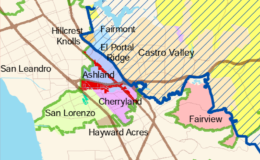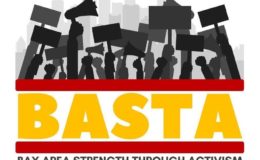CV talks biking, pedestrian safety at Monday’s MAC meeting
- By : Michael Baldwin
- Category : Governance, Public Safety
Monday’s Municipal Advisory Council (MAC) meeting attracted a crowd of about 75 people , many of whom were there to comment on potential solutions to pedestrian and bicyclist issues on Anita and Somerset Avenues (see Item IV. from this week’s MAC agenda).
Alameda County Public Works Agency Director Art Carrera presented on the scope and costs of upgrading Anita and Somerset Avenues with sidewalks and bike lanes, a project that his departments estimated as costing $3.8 million.
Anita is only 40 feet wide, and a proper sidewalk upgrade requires at least a 50-foot-wide roadway; therefore, approximately a third of the projected cost would be used to purchase right-of-way from residents to widen the road.
The County reported that the crosswalks on Anita had recently been repainted and new signage was installed for greater visibility. Plans are also in the works for traffic-calming speed humps, and paving of the unimproved shoulder areas of the road in mid-2015.

At 9,800 estimated cars per day, Somerset Avenue is three times busier than Anita; it is also wider with a 50-to-56 foot average width, according to Carrera. He presented plans to add continuous sidewalks, while retaining the street’s status as a “Class III Bike Route,” a route that does not have designated bike lanes, but where bikes share the driving lane with motorists. A Class III Bike Route requires no additional roadway. Carrera estimated the costs for upgrading Somerset at $3 to $4 million.

The County has sought funding sources for both of these projects, including recent applications to the Active Transportation Program (ATP) to start design work; however, the applications scored low in the Active Transportation Program (see page 7) and will not be funded via that program. Carrera indicated that the County is looking for more grant opportunities.
In 2004, the County estimated that the Unincorporated Areas required over $400 Million to upgrade sidewalks, including Castro Valley’s 140 miles of roadways. The funding and construction process could take up to ten years just for Somerset and Anita, Carrera said.
The bicycle and pedestrian advocacy group BikeWalkCV then presented on potential ways to add bike lanes to Somerset Avenue. The presentation described many challenges to motorists with the current street layout including gridlock, lack of clearance for passing cyclists and parked cars, and increased collisions with parked vehicles. Many cyclists believe that Somerset is too dangerous to ride in and often ride on the incomplete sidewalks, or weave in and out of parked cars for safety, according to the group.
Such conditions can be dangerous for pedestrians who are also using the incomplete sidewalks on the road, leading many walkers to choose between dodging cars in the street or bikes on the sidewalk.

BikeWalkCV proposed converting Somerset from a Class III “share the road” bike lane to a Class II roadway with dedicated striped bike lanes in both directions. To accommodate this, parking would be eliminated from one side of the street. This plan would potentially increase both bicycle and pedestrian utilization while also reducing the damages suffered by parked cars on Somerset.
There were many public comments both for and against the plan. Many residents spoke about the dangers they feel when trying to bicycle or walk down Somerset, and how these conditions force them to use their cars for even the shortest trips using the street.
Others complained that bike lines were unnecessary because of the extremely low number of cyclists currently using Somerset. Others speakers asserted that transportation policy should favor the majority of users (motorists and residents requiring on-street parking). One passionate cyclist pointed out that Castro Valley is fast becoming an epicenter for local enthusiasts, noting that there are six local bike shops within ten miles of Downtown Castro Valley. Conversely, longtime residents worried about the issues that would arise from the elimination of one longtime lane of parking on the busy thoroughfare. Finally, a representative of Bike East Bay reminded everyone that as infrastructure goes, bike lanes are cheap, and Castro Valley could explore some temporary options or trial periods for bike lanes on some streets.
The MAC noted that many good points were raised on both sides and encouraged all to continue the debate by attending the Bicycle and Pedestrian Town Hall Meeting on October 29 at 6:30 PM at the Castro Valley Library. Many experts, County Planners, local Law Enforcement agencies, and Supervisor Nate Miley will be there to brainstorm solutions.
For more background on the state of sidewalks in Castro Valley, check out our previous post, “The Missing Sidewalks of Castro Valley.”
Also on Monday:
- The meeting began with public comments dominated by many parents and residents from the area around Proctor Elementary concerned with the ongoing traffic and pedestrian issues around the school during pickup and drop off times. MAC Chair Crawford promised to review those concerns and put them on the agenda of an upcoming MAC meeting.
- Tona Henninger, Assistant Planning Director of the Alameda County Community Development Agency, reported that two enforcement officers were working on Castro Valley issues and together they have closed 297 separate issues so far this year, including five marijuana grow houses. Henninger stated that the Alameda County ban on donation collection boxes in the unincorporated communities was fully in force, and no donation collection boxes remain in the Castro Valley area.
The next Castro Valley MAC meeting will be on Monday, October 27 at 6 PM. Here’s a link to the agenda.


